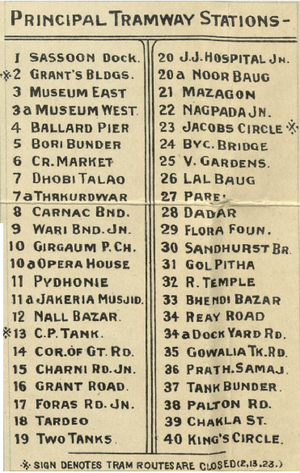Bombay Tramways
Bombay Tramways
Bombay Trams commenced in 1874 as a horse-drawn tram service in Bombay operated by the Bombay Tramway Company. In 1905, a newly formed concern, The Bombay Electric Supply & Tramways Company Limited, bought the Bombay Tramway Company and the first electrically operated tram-car appeared on Bombay's roads in 1907. The service closed on 31 March 1964


History
In January 1865 an American import-export firm , Stearn, Hobart & Co, applied to the Bombay Municipality to lay and operate a tramway system within the city, and was granted a Deed of Agreement on 28 Feb 1865. However, the end of the American Civil War had placed Bombay’s textile industry into crisis, which stopped all progress on the tramway scheme. Five years later the American firm challenged the Municipality who maintained the Agreement was not binding [1].
English firms lodged an interest and ultimately G A Kittage and F W Stearn secured the concession on 1 Mar 1873. The Bombay Tramways Company (BTC) was floated in New York and the English firm Glover & Co was employed to construct the tramway and construction commenced on 1 Jan 1874 at Colaba. After only 19 weeks the services opened from Grants Building to Pydhonie, 2.52 miles, and Bori Bunder via Kalbadevi to Pydhonie, 1.25 miles [1].
The Bombay Tramway Company Limited was established in 1873 and received a license to operate trams in the city. The Bombay Municipal Corporation (BMC) reserved the right to purchase the company after twenty-five years, and every seven years thereafter. In 1874, the government enacted the Bombay Tramways Act after the Municipality and the Company formally signed the contract to start the transport system [2].
On May 9, 1874, the first horse-drawn carriage made its début in the city, plying on the Colaba–Pydhone via Crawford Market, and Bori Bunder to Pydhonie via Kalbadevi routes. The initial fare cost three annas (15 paise), without tickets issued. As the service became increasingly popular, the fare reduced to two annas (10 paise). Later that year, the company issued tickets for the first time, to curb the increasing fareless travel [2]
In 1899, the company applied to the BMC, for operation of electrically operated trams. Due to the high investment required, the company suggested that the BMC should waive its right to take over the tramways, scheduled to take place in 1901 according to the contract signed in 1874. After due deliberations, the BMC decided to take over the company. The takeover created several legal problems, leading to the foundation of a new public company, the Bombay Electric Supply & Tramways Company Limited, which bought out the Bombay Tramway Company in 1905 [2]
The Bombay Electric Supply & Tramways Company Limited took over 17.377 miles of double track tramway, 195 single-deck tramcars, 1385 horses and 18 bullocks, together with various depots and stables. Work on conversion to electic traction started within the year and the company also applied for 5.7 route miles(9.1km) of extensions. Some of the extensions were deferred because of the narrowness of the streets – which were subsequently widened [1]
The Imperial Gazetteer of India records ‘In 1904 the Bombay Tramways, owned by the municipality and worked by a company have a length of track of 17¾ miles(28km), mostly double, and carried about 25 million passengers ... the tramway is now being converted from horse to to electric traction’ [3].
The electrified tram service began on 7 May 1907 with horse-drawn trams still performing over lines that were not yet electrified, but the whole conversion was completed by 16 May 1908 with the tramway network extended to 20.58 route miles. At the end of the year the number of passengers carried had exceeded 30million. By 1914 this was 40 million [1].
Double-deck tram service began in September 1920. At the peak of service in 1935, 433 trams ran on 29 miles(47 km) of track. The trams met travellers' needs until the betterment of the train network in the city; the service closed on 31 March 1964[4].
Records
An on-line search of the India Office Records (IOR) records held at the British Library relating to this tramway [5] gives several entries, the most relevant as follows: -
- L/PJ/6/405, File 1602; "The Bombay Tramways Act Amendment Act, 1895"
- L/PJ/6/821, File 2418; "The Bombay Tramways (Amendment) Act 1907"
- L/PJ/6/1476, File 661; "The Bombay Tramways (Amendment) Law, 1917"
External Links
References
- ↑ 1.0 1.1 1.2 1.3 [https://books.google.fr/books?id=OB9CCwAAQBAJ&pg=PT453&lpg=#v=onepage&q&f=false The Making of India: The Untold Story of British Enterprise, by Kartar Lalvani, Chapter 15 page 452-53]; Retrieved 23 Mar 2020
- ↑ 2.0 2.1 2.2 New World Encyclopedia B.E.S.T Co; Retrieved 21 Aug 2016
- ↑ "Imperial Gazetteer of India", v. 8, p. 332; 1908; Retrieved 21 Aug 2016
- ↑ "Tram Views of Asia"/India/Bombay by John Rossman 1998; Retrieved 21 Aug 2016
- ↑ “British Library Archives and Manuscripts Catalogue” - Search; Retrieved 21 Aug 2016